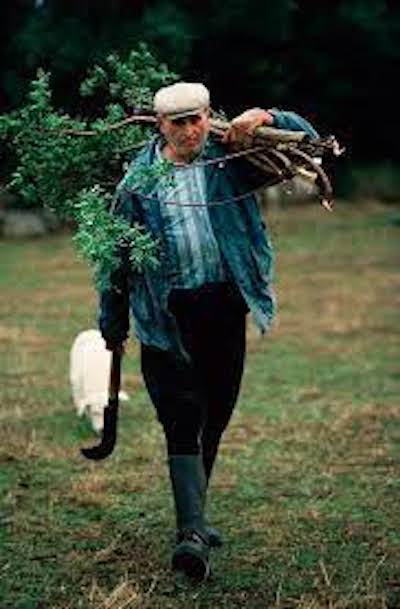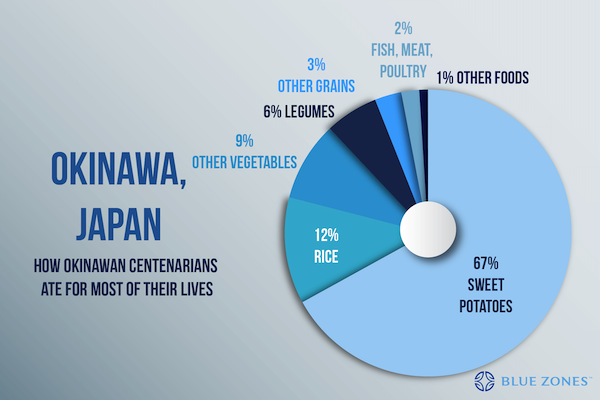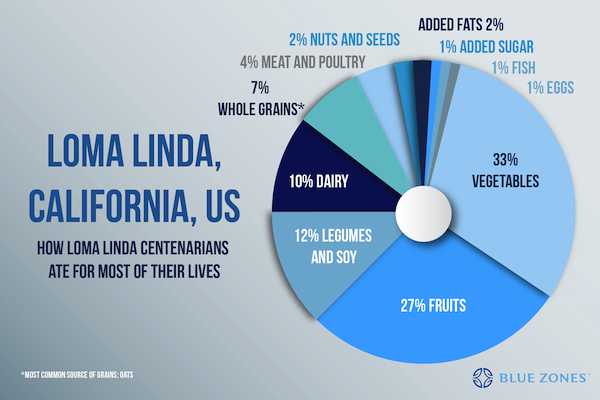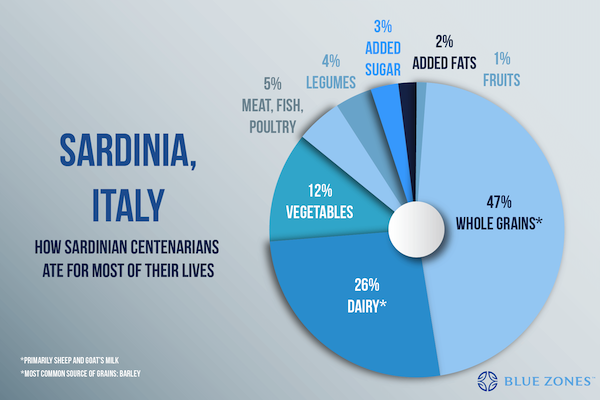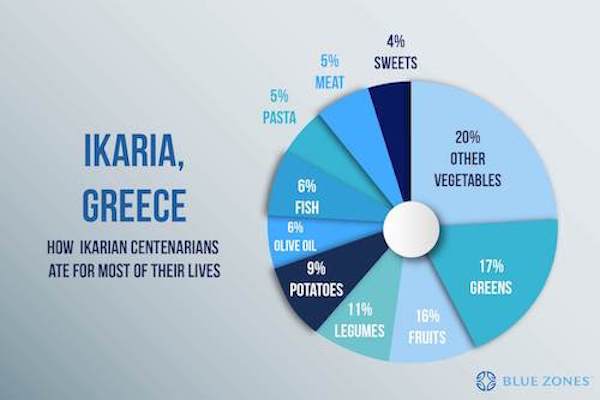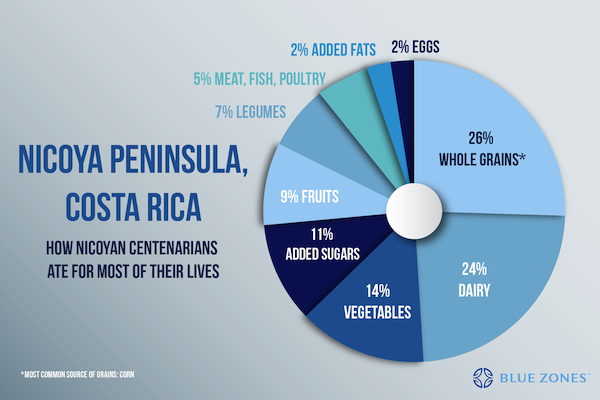The Blue Zone Diet Will Transform You
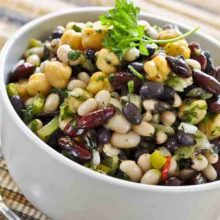
The Blue Zone diet is a plant-dominant diet eaten by the healthiest, longest-lived people on earth, who happen to cluster in five places across the globe. Learn what they eat and do to thrive, and get Dr. Michael Greger’s app!
People on the Blue Zone diet age better. Much better! They live healthier, longer than any other group of people on the planet.
Why?
They have five lifestyle factors in common, which I’ll tell you about in a moment, but — spoiler alert — two big ones are a plant-dominant diet, and daily exercise, both scientifically proven to extend healthspan.
Here's what I cover:
Let’s dive in…
Meet the Blue Zones
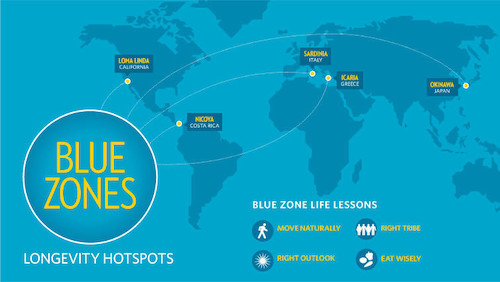
The Blue Zone Diet is shared by people living in five special places in the world, and that diet helps them live long and strong.
In 2004, Dan Buettner teamed with National Geographic, the National Institute on Aging, and the world’s best longevity researchers to identify pockets around the world where people lived measurably better and longer.
He found five such places and called them the Blue Zones.
The Blue Zones produce a high rate of centenarians, a very low incidence of chronic disease and enjoy more healthy years of life.
These are the Blue Zones:
- Ogliastra Region, Sardinia, Italy: Home to some of the oldest men in the world, who live in mountainous regions, work on farms and drink red wine with meals.
- Okinawa, Japan: Home to the world’s oldest women, who eat a lot of soy-based foods and practice tai chi, a meditative form of exercise.
- Nicoya Peninsula,Costa Rica: Their diet is based around beans and corn tortillas. People do physical jobs into old age, and have a sense of life purpose known as “plan de vida.”
- Ikaria, Greece: The people eat a Mediterranean diet rich in olive oil, red wine and homegrown vegetables
- Loma Linda, California, USA: Home to the Seventh-day Adventists, a very religious group of people who practice strict vegetarianism, and live in tight-knit communities.
In this article, Dan describes the common lifestyle factors shared between the people living in the Blue Zones. I just want to point out the profiles of a few of the people he writes about.
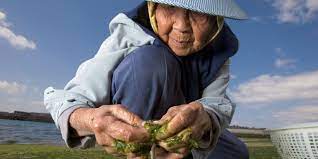 This is 89 year-old Kame Ogido from Okinawa, Japan. Look how effortlessly she squats, probably because from the time she was a child, she never stopped squatting, and didn’t compromise that ability by sitting in a chair all the time.
This is 89 year-old Kame Ogido from Okinawa, Japan. Look how effortlessly she squats, probably because from the time she was a child, she never stopped squatting, and didn’t compromise that ability by sitting in a chair all the time.
This is 84 year-old Fumlyasu Yamakawa who exercises every day, including yoga, and his sporting events are the high jump and pole vault.
And this is Yasu Itoman, 100 years old, who gets her exercise by gardening, growing fresh food high in antioxidants, polyphenols and fiber:
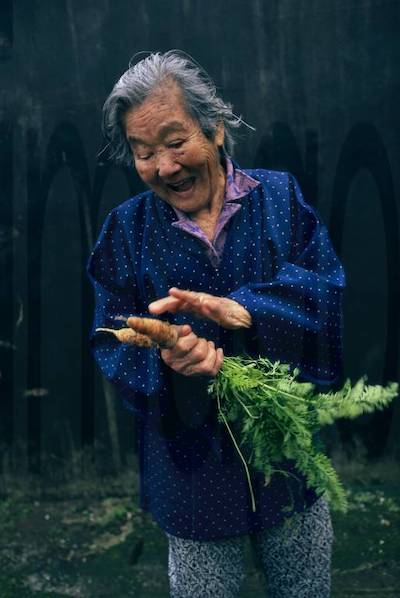
100 year old Yasu Itoman picks fresh vegetables from her garden, a source of exercise as well as antioxidants .
Next up is 100 year-old Marge Jetton from Loma Linda, California. She’s a 7th Day Adventist, a Christian religion, and the dominant religion in Loma Linda. They adhere to vegetarianism, and find purpose and social well being from their religion.
Finally, this is 75 year old Shepard Tonino Tola from Sardina, Italy. He walks and does physical work all day long:
So, what do these people, and those in the rest of the Blue Zones, have in common?
- Their diet is plant-dominant
- They exercise and/or are active throughout the day
- They drink moderate amounts of alcohol
- They get restorative sleep
- They have good spiritual, family and social networks
This post is about the Blue Zone diet, but I don’t want to leave you in the lurch about the rest of the lifestyle factors that contribute to these people’s extraordinary healthspan, so if interested, here are some links to my posts on:
Exercise — You’re not going become a work-all-day Shepard, but what about some “Exercise Snacks“, or Exercise for Longevity.
Alcohol — I haven’t written anything about how alcohol impacts healthy aging, but the National Institute on Aging has some Facts About Aging and Alcohol , including “Uncle George’s and Aunt Betty’s Stories”. (Hint: they’re not teetotalers.)
Restorative sleep — Read my posts 7 Sleeping Tips For Your Ultimate Rest and Restoration and Reduce Chronic Inflammation With Sleep.
Connection — That’s the word I think of that depicts “spiritual, family and social networks”. Humans thrive when connected. Check out Walden University’s piece, Why Social Networks Are Important to Aging Adults.
And now, back to how the Blue Zone diet confers such a robust old age to the Blue Zoners.
The Blue Zone Diet: Plant Power!
Let’s set the stage with a few depictions of what comprises a Blue Zone diet by looking at the mix of foods consumed by the people in each of the five Blue Zones:
What the Blue Zone diets depicted above have in common is that they’re typically rich in the following:
Vegetables: A great source of fiber, polyphenols, antioxidants, and many different vitamins and minerals. Eating more than five servings of fruits and vegetables a day can significantly reduce your risk of heart disease, cancer and death. A meta-analysis published in the BMJ journal concludes that:
“A higher consumption of fruit and vegetables is associated with a lower risk of all cause mortality, particularly cardiovascular mortality.”.
Legumes: Legumes include beans, peas, lentils and chickpeas, and they are all rich in fiber and protein. A number of studies have shown that eating legumes is associated with lower mortality, such as this one: Legumes: the most important dietary predictor of survival in older people of different ethnicities
Whole grains: Whole grains are also rich in fiber. A high intake of whole grains can reduce blood pressure and is associated with reduced colorectal cancer and death from heart disease:
- This study concluded: “Our meta-analysis demonstrated inverse associations of WG [whole grain] intake with total and cause-specific mortality, and findings were particularly strong and robust for CVD [cardiovascular disease] mortality.”.
- This study concluded: “Increasing the intake of fiber in Western populations, where intake is far below recommended levels, may contribute to the prevention of hypertension.”.
- This study concluded: “A high intake of dietary fibre, in particular cereal fibre and whole grains, was associated with a reduced risk of colorectal cancer.”.
Nuts: Well, actually, nuts comprises a tiny bit of the typical Blue Zone diet, but I’m nuts about nuts, and for good reason. Nuts are great sources of fiber, protein and polyunsaturated and monounsaturated fats. Combined with a healthy diet, they’re associated with reduced mortality and may even help reverse metabolic syndrome (18Trusted Source, 19Trusted Source, 20Trusted Source).
- This study concluded: “Nut consumption was associated with decreased overall and cardiovascular disease mortality across different ethnic groups and among individuals from low SES [low socioeconomic status] groups.”.
- This study concluded: “Our meta-analysis indicates that nut intake is inversely associated with IHD [ischemic heart disease], overall CVD [cardiovascular disease], and all-cause mortality but not significantly associated with diabetes and stroke… These findings support recommendations to include nuts as part of a healthy dietary pattern for the prevention of chronic diseases.”.
There are some other dietary factors that define each of the Blue Zones. For example, fish is often eaten in Icaria and Sardinia. Fish is a good source of omega-3 fats, which are important for heart and brain health, but be aware that farmed fish often have parasites and antibiotics in them, and that fish in general often contain undesirable amounts of mercury and microplastics.
Did you notice what is rarely eaten in the typical Blue Zone diet, the food group that is just a sliver in each of the five Blue Zones?
Meat
The maximum percentage of meat consumed as a portion of total food consumed in the Blue Zone diet is 5%. Turns out, minimizing meat consumption is a good thing to improve healthspan.
A number of studies show that a meat-dominant diet results in poor health outcomes. For example, this animal and plant protein study of 131,342 participants published in the highly regarded JAMA Internal Medicine journal concluded:
“High animal protein intake was positively associated with cardiovascular mortality and high plant protein intake was inversely associated with all-cause and cardiovascular mortality, especially among individuals with at least 1 lifestyle risk factor. Substitution of plant protein for animal protein, especially that from processed red meat, was associated with lower mortality, suggesting the importance of protein source.
Now, let me address something you might be thinking; something like this:
OK, low meat consumption might work in their favor, but how do you know it was the plant-dominant diet that conferred such robust health well into old age, and not the other things these Blue Zoners have in common, such as exercising, or social bonding, or genetics?
First, the scientific papers cited above gives you some answers about the health-attributable powers of plant food,
Second, the Blue Zone people thrive well into old age, not because of genetics, or some special mineral in the water, but because, in large part, they eat a lot of plant food.
Many studies have concluded that genetics probably only account for 20–30% of longevity. This one published in the journal Immunity and Aging is indicative of the rest and concludes that “about 25 % of the variation in human longevity is due to genetic factors”.
So, good genes or not, plants can make a big difference in how well you age.
Check out the infographic below to get a good summary of the value of eating the Blue Zone diet:
It would serve you well to remember this from the Eating Plants infographic:
- A plant-dominant diet, like the Blue Zone diet, basically consists of minimally processed whole foods, a maximum fruit and vegetable intake and eliminating or limiting meat, eggs and dairy.
- Dieters lose more weight on every variation of a plant-dominant diet as compared to an omnivore diet.
- A plant-dominant diet may reduce chronic inflammation associated with cancer and heart disease.
- A plant-dominant diet may reduce nearly every chronic disease associated with aging, such as hypertension, type 2 diabetes, cognitive decline and rheumatoid arthritis.
So, how do you get started eating a Blue Zone diet?
Start Eating More Plant Food Guided by Dr. Greger’s Daily Dozen App
Readers of this blog know that I’m a fan of Dr. Michael Greger, the rare physician who is an expert in nutrition. He runs the non-profit NutritionFacts.org website, where there are thousands of videos on nutrition research.
Check out Dr. Greger’s eight minute video, How Not to Die: An Animated Summary, which provides a good summary of the value of a plant-dominant diet.
Intrigued?
Wanna take a step into the vegetable garden?
Well, Dr. Greger’s got you covered with his Daily Dozen app. I use it every day to check off my food selection and remind me what to include in my diet each day.
Here’s what it does:
One of the things I most love about the Daily Dozen app are the links to the latest nutrition research, so if you’re wondering, Why am I supposed to be eating flax seeds every day?, you’re just one click away on the app to learning why.
Get your Daily Dozen app for your smart phone:
And then dig into Dr. Greger’s easy-to-make recipes
Questions or comments?
Scroll down and have at it!
Last Updated on November 7, 2022 by Joe Garma





